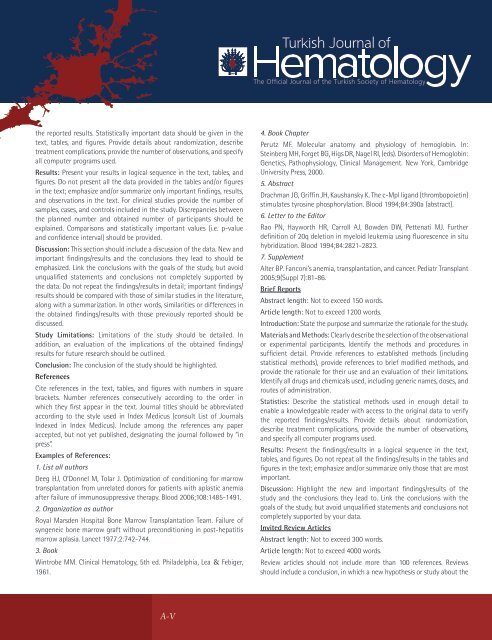Turkish Journal of Hematology Volume: 34 - Issue: 1
Create successful ePaper yourself
Turn your PDF publications into a flip-book with our unique Google optimized e-Paper software.
the reported results. Statistically important data should be given in the<br />
text, tables, and figures. Provide details about randomization, describe<br />
treatment complications, provide the number <strong>of</strong> observations, and specify<br />
all computer programs used.<br />
Results: Present your results in logical sequence in the text, tables, and<br />
figures. Do not present all the data provided in the tables and/or figures<br />
in the text; emphasize and/or summarize only important findings, results,<br />
and observations in the text. For clinical studies provide the number <strong>of</strong><br />
samples, cases, and controls included in the study. Discrepancies between<br />
the planned number and obtained number <strong>of</strong> participants should be<br />
explained. Comparisons and statistically important values (i.e. p-value<br />
and confidence interval) should be provided.<br />
Discussion: This section should include a discussion <strong>of</strong> the data. New and<br />
important findings/results and the conclusions they lead to should be<br />
emphasized. Link the conclusions with the goals <strong>of</strong> the study, but avoid<br />
unqualified statements and conclusions not completely supported by<br />
the data. Do not repeat the findings/results in detail; important findings/<br />
results should be compared with those <strong>of</strong> similar studies in the literature,<br />
along with a summarization. In other words, similarities or differences in<br />
the obtained findings/results with those previously reported should be<br />
discussed.<br />
Study Limitations: Limitations <strong>of</strong> the study should be detailed. In<br />
addition, an evaluation <strong>of</strong> the implications <strong>of</strong> the obtained findings/<br />
results for future research should be outlined.<br />
Conclusion: The conclusion <strong>of</strong> the study should be highlighted.<br />
References<br />
Cite references in the text, tables, and figures with numbers in square<br />
brackets. Number references consecutively according to the order in<br />
which they first appear in the text. <strong>Journal</strong> titles should be abbreviated<br />
according to the style used in Index Medicus (consult List <strong>of</strong> <strong>Journal</strong>s<br />
Indexed in Index Medicus). Include among the references any paper<br />
accepted, but not yet published, designating the journal followed by “in<br />
press”.<br />
Examples <strong>of</strong> References:<br />
1. List all authors<br />
Deeg HJ, O’Donnel M, Tolar J. Optimization <strong>of</strong> conditioning for marrow<br />
transplantation from unrelated donors for patients with aplastic anemia<br />
after failure <strong>of</strong> immunosuppressive therapy. Blood 2006;108:1485-1491.<br />
2. Organization as author<br />
Royal Marsden Hospital Bone Marrow Transplantation Team. Failure <strong>of</strong><br />
syngeneic bone marrow graft without preconditioning in post-hepatitis<br />
marrow aplasia. Lancet 1977;2:742-744.<br />
3. Book<br />
Wintrobe MM. Clinical <strong>Hematology</strong>, 5th ed. Philadelphia, Lea & Febiger,<br />
1961.<br />
4. Book Chapter<br />
Perutz MF. Molecular anatomy and physiology <strong>of</strong> hemoglobin. In:<br />
Steinberg MH, Forget BG, Higs DR, Nagel RI, (eds). Disorders <strong>of</strong> Hemoglobin:<br />
Genetics, Pathophysiology, Clinical Management. New York, Cambridge<br />
University Press, 2000.<br />
5. Abstract<br />
Drachman JG, Griffin JH, Kaushansky K. The c-Mpl ligand (thrombopoietin)<br />
stimulates tyrosine phosphorylation. Blood 1994;84:390a (abstract).<br />
6. Letter to the Editor<br />
Rao PN, Hayworth HR, Carroll AJ, Bowden DW, Pettenati MJ. Further<br />
definition <strong>of</strong> 20q deletion in myeloid leukemia using fluorescence in situ<br />
hybridization. Blood 1994;84:2821-2823.<br />
7. Supplement<br />
Alter BP. Fanconi’s anemia, transplantation, and cancer. Pediatr Transplant<br />
2005;9(Suppl 7):81-86.<br />
Brief Reports<br />
Abstract length: Not to exceed 150 words.<br />
Article length: Not to exceed 1200 words.<br />
Introduction: State the purpose and summarize the rationale for the study.<br />
Materials and Methods: Clearly describe the selection <strong>of</strong> the observational<br />
or experimental participants. Identify the methods and procedures in<br />
sufficient detail. Provide references to established methods (including<br />
statistical methods), provide references to brief modified methods, and<br />
provide the rationale for their use and an evaluation <strong>of</strong> their limitations.<br />
Identify all drugs and chemicals used, including generic names, doses, and<br />
routes <strong>of</strong> administration.<br />
Statistics: Describe the statistical methods used in enough detail to<br />
enable a knowledgeable reader with access to the original data to verify<br />
the reported findings/results. Provide details about randomization,<br />
describe treatment complications, provide the number <strong>of</strong> observations,<br />
and specify all computer programs used.<br />
Results: Present the findings/results in a logical sequence in the text,<br />
tables, and figures. Do not repeat all the findings/results in the tables and<br />
figures in the text; emphasize and/or summarize only those that are most<br />
important.<br />
Discussion: Highlight the new and important findings/results <strong>of</strong> the<br />
study and the conclusions they lead to. Link the conclusions with the<br />
goals <strong>of</strong> the study, but avoid unqualified statements and conclusions not<br />
completely supported by your data.<br />
Invited Review Articles<br />
Abstract length: Not to exceed 300 words.<br />
Article length: Not to exceed 4000 words.<br />
Review articles should not include more than 100 references. Reviews<br />
should include a conclusion, in which a new hypothesis or study about the<br />
A-V

















